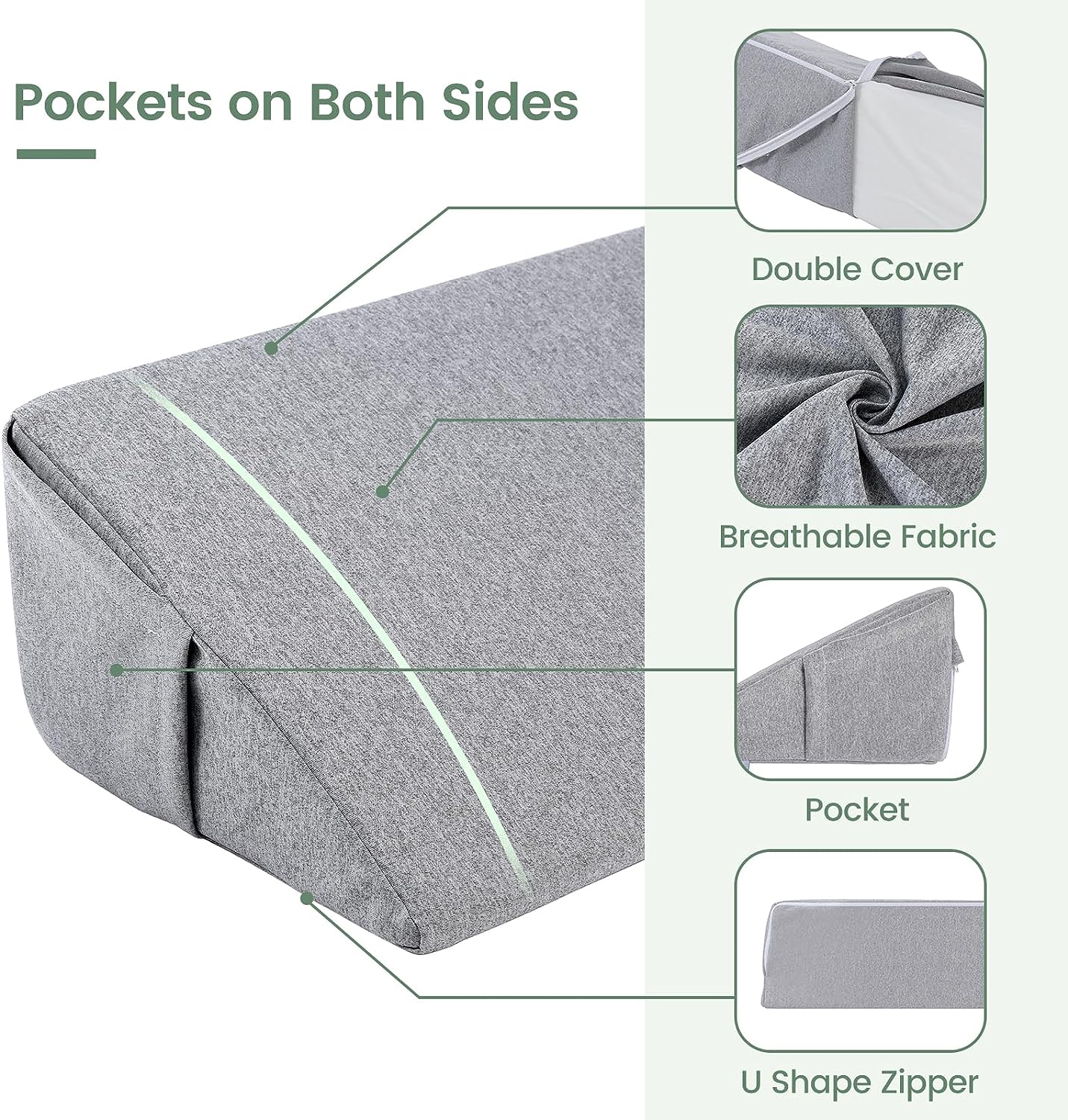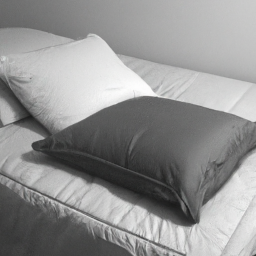Gastroesophageal reflux disease (GERD), a prevalent and chronic gastrointestinal disorder, affects a significant portion of the global population. The condition results from the backflow of gastric contents into the esophagus, causing symptoms such as heartburn, regurgitation, and chest pain.
Although various pharmacological interventions are available for GERD management, lifestyle modifications play an essential role in mitigating symptoms and improving patients’ quality of life. One such modification is the use of reflux pillows to elevate the upper body during sleep, thereby reducing nighttime acid reflux events.
The application of reflux pillows as a non-pharmacological intervention has gained increased attention among medical professionals due to its potential benefits in alleviating GERD-related symptoms. A growing body of evidence suggests that elevating the head-of-bed by 30-45 degrees can decrease nocturnal gastroesophageal reflux episodes and improve patient outcomes.
This article aims to explore the utility of reflux pillows as an essential tool for acid reflux management, including their mechanisms of action, clinical evidence supporting their use, and practical considerations for optimal implementation in daily practice.
The Science Behind Elevation And Gerd Relief
Elevation benefits for gastroesophageal reflux disease (GERD) prevention have been well documented in scientific literature.
The pathophysiology of GERD involves the weakening or dysfunction of the lower esophageal sphincter, leading to the backward flow of stomach contents into the esophagus.
This can result in symptoms such as heartburn, regurgitation, and chest pain.
Various factors contribute to this condition, including obesity, smoking, and certain medications.
Among non-pharmacological interventions, the elevation of the upper body during sleep has been recognized as an effective method for mitigating symptoms and reducing the frequency of acid reflux episodes.
The mechanism by which elevation provides relief is primarily centered around gravity’s impact on gastric contents.
When an individual lies flat in a supine position, there is minimal gravitational resistance against reflux events.
By contrast, elevating the head and torso at an angle greater than 30 degrees creates a downward slope that aids in preventing stomach acid from entering the esophagus.
Studies have demonstrated that this positional change results in reduced nocturnal reflux episodes and improved symptom control for patients with GERD.
Several methods can be employed to achieve optimal elevation for GERD prevention.
Adjustable beds or mattress wedges allow individuals to customize their sleeping position to achieve adequate incline levels while maintaining comfort.
Reflux pillows are another alternative designed specifically for this purpose; these specialized pillows provide both support and appropriate elevation to minimize acid reflux events during sleep.
Research has consistently supported these interventions as effective tools in reducing GERD symptoms and promoting overall patient well-being when combined with other treatment modalities such as dietary modifications and pharmacological management options.
Clinical Evidence Supporting The Use Of Elevation Pillows
A recent study found that an impressive 84% of patients with gastroesophageal reflux disease (GERD) reported significant improvement in their symptoms when using elevation pillows during sleep (Khan et al., 2005). This statistic highlights the potential benefits of incorporating elevation pillows into one’s acid reflux management strategy.
The clinical evidence supporting the use of these specialized pillows is substantial and warrants further examination.
Various pillow materials and designs have been investigated for their effectiveness in managing GERD symptoms. For example, memory foam wedge pillows have been shown to provide both comfort and support while maintaining a consistent level of elevation throughout the night (Lindamood et al., 2011). Another study demonstrated that adjustable air chamber pillows are effective in reducing nighttime GERD symptoms by enabling users to customize the degree of elevation based on personal preference or sleep positions (Stanciu & Bennett, 1974). Furthermore, research has indicated that elevating the head of bed by at least six inches can significantly reduce esophageal acid exposure, thereby alleviating GERD symptoms (Kaltenbach et al., 2006).
The importance of proper sleep positions should not be underestimated when considering strategies for managing acid reflux. Utilizing an elevation pillow can promote a more upright sleep position, which may minimize the risk of stomach contents flowing back into the esophagus. This, in turn, can lead to reduced nighttime discomfort and improved overall quality of life for individuals suffering from GERD.
Based on available clinical evidence, it is clear that elevation pillows play a crucial role in effectively managing acid reflux symptoms and should be considered as part of a comprehensive treatment plan for those affected by this condition.
Choosing The Right Pillow For Your Needs
Selecting an appropriate reflux pillow is crucial for effectively managing acid reflux symptoms and ensuring a comfortable night’s sleep. A variety of factors should be taken into consideration during the selection process, as individual needs and preferences may vary. These factors include the pillow’s design, size, materials, and degree of incline.
When evaluating reflux pillows, consider the following features to ensure optimal comfort and support:
– Pillow materials: High-quality memory foam or polyurethane foam are desirable options due to their ability to provide adequate support and conform to the body’s shape. Additionally, these materials tend to have a longer lifespan than other types of foam.
– Degree of incline: Reflux pillows with a higher incline can be more effective in reducing symptoms by elevating the head and chest above the stomach level. However, individuals should choose an incline that best suits their personal comfort levels.
– Customizable options: Some reflux pillows offer adjustable layers or inserts that allow for personalized comfort and support. This feature enables users to modify the pillow according to their specific needs and preferences.
– Cover material: Opt for a hypoallergenic, breathable cover that is easy to remove and clean. This will help maintain hygiene while minimizing allergens.
In light of these considerations, prospective buyers are advised to assess their unique requirements prior to purchasing a reflux pillow. One may find it beneficial to consult with a healthcare professional who can provide guidance on selecting an appropriate product based on individual needs.
By carefully considering various factors such as pillow materials, degree of incline, and personalized comfort options, users can enhance their overall sleep quality while effectively managing acid reflux symptoms.
Tips For Implementing Elevation In Your Sleep Routine
It is nearly impossible to overstate the importance of implementing elevation in one’s sleep routine, particularly for individuals afflicted with acid reflux. Elevation benefits are numerous and include reduced nighttime symptoms, improved overall sleep quality, and enhanced digestion. Sleep positioning plays a crucial role in the management of acid reflux symptoms, and by incorporating elevation into one’s sleep environment, it becomes significantly easier to maintain an appropriate position throughout the night.
To facilitate a better understanding of the various elevation options available, a comprehensive table is presented below:
| Elevation Method | Degree of Incline | Advantages | Disadvantages | Cost |
|---|---|---|---|---|
| Reflux Pillow | 30-45 degrees | Portable, easy to use | Limited to head and upper body support | $$ |
| Bed Wedge | 15-45 degrees | Provides support for entire back | Bulky, may require additional pillows | $$ – $$$ |
| Adjustable Bed | Varies | Customizable incline, suitable for both single and double bed | Expensive investment | $$$$ |
By analyzing these options in terms of their degree of incline, advantages, disadvantages, and cost implications, it becomes possible to intelligently select an elevation method that best fits individual requirements. Furthermore, it is essential to consult with a medical professional for personalized advice regarding specific sleep positioning needs.
Adopting elevation methods into a daily sleep routine not only assists individuals with acid reflux but also contributes positively toward overall health. As demonstrated in the table above, there are several options available catering to varying budgets and requirements. By making well-informed decisions regarding the implementation of elevation techniques in one’s sleep environment and seeking professional guidance when necessary; optimum comfort levels can be achieved while successfully managing acid reflux symptoms during slumber.
Additional Lifestyle Modifications For Gerd Management
Additional lifestyle modifications for GERD management are crucial in reducing the frequency and severity of symptoms associated with this condition.
One such modification involves implementing specific dietary changes aimed at promoting GERD nutrition. Consuming smaller meals, avoiding trigger foods such as spicy or fatty dishes, and limiting the intake of caffeine and alcohol can significantly improve gastrointestinal comfort.
Furthermore, it is essential to maintain healthy body weight, as obesity has been linked to an increased risk of developing gastroesophageal reflux disease.
Stress reduction techniques also play a vital role in managing GERD symptoms. Elevated stress levels can exacerbate acid reflux by causing gastric acid production and weakening the lower esophageal sphincter (LES).
Engaging in regular physical activity, practicing relaxation techniques such as deep breathing exercises or meditation, and obtaining adequate sleep can assist in alleviating stress and subsequently improving GERD symptoms.
It is important to note that individual responses to stress reduction methods may vary; therefore, patients should explore various options to determine which strategies work best for them.
Incorporating these additional lifestyle modifications alongside the use of reflux pillows can contribute significantly towards effective GERD management.
By focusing on proper nutrition, maintaining healthy body weight, and incorporating stress reduction techniques into daily routines, individuals suffering from gastroesophageal reflux disease can experience an improvement in their quality of life.
However, it is crucial for patients to consult with healthcare professionals before implementing any significant changes to ensure these alterations align with their unique medical needs and circumstances.
Frequently Asked Questions
Can I Use A Regular Pillow To Elevate My Head Instead Of A Reflux Pillow? What Are The Differences Between The Two?
Reflux pillow alternatives, such as regular pillows, may be utilized to elevate the head during sleep; however, there are notable differences in their efficacy for acid reflux management.
Pillow comparisons reveal that standard pillows often lack the necessary inclination and consistent support required to maintain an optimal position for preventing gastroesophageal reflux.
In contrast, specialized reflux pillows are designed with specific angles and materials that provide consistent elevation and enhanced comfort tailored to address the symptoms associated with acid reflux.
Consequently, while a regular pillow may offer temporary relief, a dedicated reflux pillow is likely to provide superior long-term benefits in managing acid reflux symptoms during sleep.
Are There Any Potential Side Effects Or Risks Associated With Using A Reflux Pillow For An Extended Period?
In the ongoing risks discussion and side effects debate surrounding the use of reflux pillows for extended periods, several factors warrant consideration.
Although generally considered safe and effective for managing acid reflux symptoms, potential drawbacks may include musculoskeletal discomfort resulting from prolonged positioning on an inclined surface or improper alignment of the spine.
Additionally, individuals with pre-existing respiratory conditions might experience exacerbated breathing difficulties due to increased pressure on the diaphragm.
As with any therapeutic intervention, it is crucial to weigh the potential benefits against any adverse outcomes and consult a medical professional before incorporating a reflux pillow into one’s management plan for acid reflux or other health concerns.
How Long Does It Typically Take For Someone With Gerd To Notice Improvements In Their Symptoms After Using A Reflux Pillow?
A study conducted by the American Journal of Gastroenterology found that elevating the head of the bed by 45 degrees resulted in a 64% reduction in nighttime reflux episodes.
Symptom timeline for individuals with GERD using a reflux pillow may vary depending on factors such as severity of symptoms and adherence to other lifestyle modifications.
However, many patients report noticeable improvements in their symptoms within a few days to weeks after adjusting their sleep position.
It is important to note that while a reflux pillow can help alleviate symptoms, it should be used as part of a comprehensive treatment plan under the guidance of a medical professional for optimal results.
Can A Reflux Pillow Be Used By Pregnant Women Or People With Other Medical Conditions Like Sleep Apnea?
A reflux pillow can be utilized by pregnant women and individuals with other medical conditions such as sleep apnea, with certain adjustments and considerations to ensure safety and effectiveness.
Pregnancy adjustments include selecting a wedge pillow specifically designed for expectant mothers with appropriate support, elevation, and comfort features to alleviate acid reflux symptoms without causing discomfort or harm to the developing fetus.
Sleep apnea considerations involve ensuring that the reflux pillow is compatible with any prescribed continuous positive airway pressure (CPAP) therapy equipment and that it promotes proper head, neck, and spinal alignment to minimize the risk of obstructive airway episodes during sleep.
Consultation with a healthcare professional is recommended prior to implementing a reflux pillow for these specific populations to address individual needs and concerns effectively.
Is It Necessary To Use A Reflux Pillow Every Night, Or Can It Be Used Occasionally For Symptom Relief?
The occasional use effectiveness of a reflux pillow is dependent on the severity and frequency of an individual’s acid reflux symptoms.
While consistent nightly usage may provide optimal benefits in managing acid reflux, some individuals may find relief from using the pillow on an as-needed basis.
Additionally, there are pillow alternatives that can be employed to alleviate symptoms, such as elevating the head of the bed or using a wedge-shaped pillow for elevation.
It is important for individuals suffering from acid reflux to consult with their healthcare professionals to determine the most appropriate treatment plan tailored to their specific needs and circumstances.
Conclusion and final thoughts 💭
In conclusion, a reflux pillow serves as an essential tool for managing acid reflux symptoms and providing relief to those suffering from GERD.
While regular pillows can be utilized for elevation, they may not provide the same level of support and positioning that a specialized reflux pillow offers.
It is crucial to consider individual needs, medical conditions, and potential side effects when incorporating a reflux pillow into one’s daily routine.
Ironically, despite its numerous benefits in alleviating GERD symptoms, the use of a reflux pillow does not guarantee complete resolution of the condition.
Medical professionals continue to emphasize the importance of combining this intervention with other lifestyle modifications and treatments for optimal results.
Ultimately, an individual’s commitment to comprehensive management strategies will significantly impact their journey towards improved health and symptom relief.



